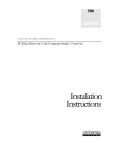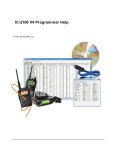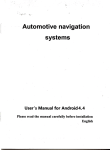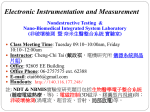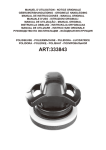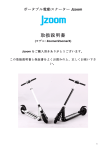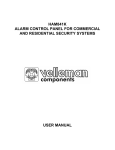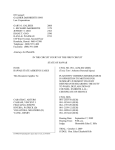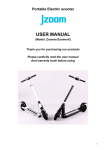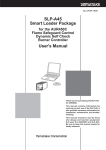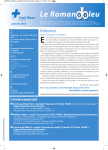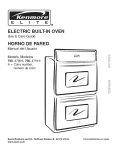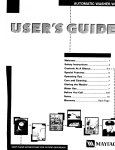Download Semi-automated pipetting aid
Transcript
US 20060188406A1 (19) United States (12) Patent Application Publication (10) Pub. No.: US 2006/0188406 A1 Frost, III (43) Pub. Date: (54) SEMI-AUTOMATED PIPETTING AID (76) Inventor: James Dahle Frost III, The Aug. 24, 2006 Publication Classi?cation (51) Woodlands, TX (US) Int. Cl. B01L 3/02 (52) US. Cl. (2006.01) ............................................................ .. 422/100 Correspondence Address: MARK A OATHOUT 3701 KIRBY DRIVE, SUITE 960 HOUSTON, TX 77098 (US) (21) APPL NO. 11/189,456 (22) JUL 26, 2005 Filed; Related US, Application Data (57) ABSTRACT A semi-automated pipetting apparatus has a computer moni tor With a screen lying in at least a nearly horizontal plane. A screen protector is mounted over the screen. Aprocessing unit runs a computer program and is in communication With the computer monitor to generate a screen display shoWn on the screen. The screen display indicates at least one target (63) Continuation-in-part of application No. 11/061,976, ?led on Feb. 18, 2005. location for the placement of a Vial, for pipetting or for sorting of items. Patent Application Publication Aug. 24, 2006 Sheet 1 0f 16 US 2006/0188406 A1 Patent Application Publication Aug. 24, 2006 Sheet 2 0f 16 95> .36, Fféll US 2006/0188406 A1 Patent Application Publication Aug. 24, 2006 Sheet 3 0f 16 US 2006/0188406 A1 50 V 01mm mt'ormahon sent wu‘clesslj; to /! / I, i I i Bluctooth 01' wireless tranmnitter E S W63 Patent Application Publication Aug. 24, 2006 Sheet 4 0f 16 US 2006/0188406 A1 Clicking here will paste the data in the clipboard into cell A4 of this worksheet Clicking this button will allow the user to save the data in this worksheet into another ?le. The default directory for saving a user ?le is C:\Program Files\WellAware\User Filesl. (text only no formatting). Using this button will prevent inadvertent formatting to be added to the Setup Click here to Run Main spreadsheet when copying information Clicking here will clear WellAware Program. from other spreadsheets. all data on the fonn. D Microsoft Excel — WellAware_l lDlZUlHnds 15%] Eite gm: ‘itew insert Format This button opens a saved user program loot-s 28 LED EB QQ|é4l3kl§?l¥ 123L3 ! iv; A l and puts the data in the Setup spreadsheet. ?t B l c t D WellAware’" pipetting @‘e l c-f' Back COIDI Source ‘Tune stamp 117mg."- t nninnihri] scum] SM‘ @9 nisplay ame This buttonsorts the Setup spreadsheet um" ""‘um by the Multi-channel Pipet Sync ?eld. This Ty "1' "r" 501.0 / ul um ' .Md ate 1;‘ m w Pl 819 mitt v (a e) Elm \ umn limit : a ‘.1 ‘7 .3. allows the person setting up a multi- 5 m in um ‘is? at‘ lTiI l!“ .channe| pipetting operation to son the 1 1611/ ul 11m .58} WE"- Ili- l1; Button map ":0 “I m sync tield in order to get the pipetting 2 operations In the correct order. 1 This bum" sh°ws the Ettcelftoolbars and the Windows taskbar in the ._ v :i; ‘T22:- ‘ ' .55‘ This button plays the WeHAware Wa|kihrough video Footswitch This button opens'a common pipetting ' program and puts the event a macro does not ' Tully ?msh‘ :2 = of Optional m- ‘ data in the Setup ‘ This button opens the > I ‘ WellAware product manual PDF ?le. -"n .i n‘u-Il". 2, PlPET lNG AlD 2” QWI'H i‘h m‘ E‘ "1' 7 Active P.,‘_ . Figure 4 WellAware Setup Spreadsheet Main Button Descriptions Patent Application Publication Aug. 24, 2006 Sheet 5 0f 16 US 2006/0188406 A1 WellAware'" PIPETTINB AID 8mm \thll?ate? (81mm!!!) mamp [The im yw Plum 83:: s we“ he sample) High volurhe highlighted Soulce Dispiay llama Volume for Sauna This data allows high 1 and low volumes to'be highlighted This record after hitting the Run Button 501.0 ul dna Figure 5 WeIlAware Setup Spreadsheet Features Patent Application Publication Aug. 24, 2006 Sheet 6 of 16 US 2006/0188406 A1 This button hides the Excel toolbars, tabs and the Windows taskbar. This allows the user to format their LCD screen for This button shows the Excel toolbars and the Windows taskbar once the user is ?nished formatting the screen after hitting the Hide Menus Button. pipetting. This button allows the user to save the screen formatting changes. 1% So u rce tide These buttons allow the user to move the Sample plate right or left. The outside buttons move the plate template a lot and the inside buttons move the template a little. Welliware“ PlPETTlNG AID l These buttons allow the user to move the Target plate right or left. The outside buttons move the plate template a lot and the inside buttons move the template a little. l Foot Switch :"aE oooooooooooooauoooooooou OOOOOOOOOOOO OOOOOOOOOOOO 000000000900 000090000000 000000000000 000000000000 000000000000 Zoo'n . oaooooaooaooooeoaooooonn ln s nooooooooouooooocooooooo oooaoonooooauouoocoooooo Plate “9 aoooeoooooooooooooooeoou ooouoouooocooboouoooovuo nocuooouoooooooooaooocou oooooooooooooeoooeoooooo Plate uoaoooooooooooooooooococ r (19M oooovooooaoooooouoooooou ooooocouoaooanooocoooaoo These buttons allow the user to These buttons allow the user to zoom the worksheet view In or Out. move the Sample and Target plates Up or Down. The big outside If your plate templates are too big buttons move the plate templates a lot the inside smaller buttons move the templates a little. or too small, use these buttons. The big outside buttons zoom the view a lot & the inside smaller buttons 3 little. Figure 6 The Pipetting Tab Button Descriptions Patent Application Publication Aug. 24, 2006 Sheet 7 0f 16 US 2006/0188406 A1 Instructions for the WellAware LCD calibration: 1. Click the WellAware Pipetting Tab and click the Edit button 2 Put a 384-well plate onto the LCD screen over one of the 384 well templates and adjust the zoom so that the yellow dots are centered under each well of the plate. 3. Next put the 384-well plate along the bottom of the LCD screen and adjust the plates up or down until the bottom row of the 384 well template is centered on the bottom row of the 384 well plate. 4. Now put the 384-well plate in the lower left corner of the LCD screen and adjust the Source plate template until all wells are centered. 5. Move the 384 well plate to the lower right corner of the screen and do the same adjustment for the Target plate. 6. Once you are happy with the adjustments to your pipetting template, hit the Save button. lAwar'e'" tPETTiNG AID Q" T lMI R izillilnvlouun I1:05‘!IsuIllznlcvsunnnzonlzull oneoeooonenocoooeononcea ooooooooeooo 0 oonooooooooooooooooooooo oooooaooooooo 0 00000.00 00aaoooouonooooooococoeo' 0909000000609 0 ouanouoo occooooooooooouuuoeocuau oenaccnaneooa 0 00000000 continue‘: oooaaonouooeaooeoooonaeu oooooaeoooooo a 00000000 nncoaeunooonnnoooonaooao Vooooeaoooooao o oouuoeoo. oeaooooouonuo a eonocooonoooo o aooooouo necuuooocoano o aooooneo '?eoooooaonooooooooooocon ooonenoooonoaaaoaoaoauea unonnoaoooooooooaooooooo ooooooooeooooaooooovonoo oooooeoououoooooeoooaaen ..‘._ zxm;n'ak m uooounnuuauauunuanaocuoa oooonnoooonoooooenoocleu DOM i *' ‘' aooooooonooonaonooonoeoo ZWW’P'R aonooooaonnooaoaeoonoooo m'zoom’ oooaoeooeooooooooooooooo ‘ oaunooov ocunecnouoono 0 ooooaonaaaono n aoauceoo ooaoocnooeeoo o oaooaoou 00000000 0000000000000 0 00000000 ooooeooooocno 0 00000000 oeoooooo_ooooo o eoaaooon aouuaoa'oooooo o ooooooon F|gure7 Suggested button order for calibrating the LCD screen Patent Application Publication Aug. 24, 2006 Sheet 8 of 16 This column contains a Time stamp that is recorded into this ?eld by the Main program. A These columns contain the Source well row and column information. Since the time stamp is recorded Pipetting Form automatically every time the operator selection is for a bar coded or non-bar acknowledges a pipetting action. The coded Sample, the spreadsheet will format user should leave this blank or the main program will skip that the cells red to alert the operator that it is a vial and not a plate. record‘ View Figure 6 to see this record on the Pipetting tab while the US 2006/0188406 A1 This is the Target P'ale > PE ‘N E lD Type to be used for the “r” "“‘ no em r“ a“ Target. Use the pull down list to select the Sm m correct form. “33E” 2;: cm“ mam. program '5 This column contains runmng' the Plate number or barcode for the Target. View Figure 7 to see ' this record on the . Pipetting tab while the . tggligglztnxe?ogladnmsn mam- program '8 information running. ' This column contains the Target well row information. This column contains the Plate number or barcode for the Source. In the case of a vial, it should contain This column contains the Multi-channel Pipet a unique barcode for the vial. Sync information which allows multiple wells to This column contains This is the Source Plate Type to be used for the Source plate. the Source well row information. This column contains the Source well column information. be lit up at the same time. All characters Use the pull down list that are the same and are consecutive will be lit up at the same time. to select the correct form. multi-channel pipetting. This feature allows for This column contains the Source volume to This column contains the Source name and the volume to be be pipetted. displayed on Pipetting tab. Figure 8 WellAware Setup Data Entry Descriptions Patent Application Publication Aug. 24, 2006 Sheet 9 0f 16 The Source number or This ce|| indicates baroode will be visible here. If the font is red it indicates a plate or vial how many pipetting aciions are required to complete the gpljan?gi?gfrggige previous current Target plate. 82:2? 'lg‘r‘? “vn 7 of 9 this Target plate ‘ Milrmnlllixnnl ' f g l, 1 v W PIPETTI N6 All) will be visible here. ~___:——'J i > ‘ i ' The Target plate number or bar-code v M 334 \ \- " ' ;‘ q H v 'j“ ‘ > 5‘ ' ‘V US 2006/0188406 A1 ‘ 25 O u l d na If the font is red it Hit Enter for next indicates a plate Sample or Esc to Exit change the main program. liiliblIBllllllilllllilil‘llllilIlllI A . Barcoded Sample Containe Z I M 5‘ Template for a barooded vial or bottle —/ Template for a 384 . well plate Figure 9 View of Main Program running a Bar-coded Source. Patent Application Publication Aug. 24, 2006 Sheet 10 0f 16 .a . soil . Excel sl'lisulergetpP'ate , 7 \ 1m‘ US 2006/0188406 A1 I'll Wellltware lPETTlNE AlD 5% SWII‘ZISIIISI‘I'IIIIQIIIIII A a; 5h; g “H 1 UP g. “4. 52m w i Pr“ t F U3 l gZovm Q Du: 2 D E 3 ‘ PM: ; lbw/r I ' J K L F'''” jZoom Plate 1 0.11 iD0wn¢ M \ This is the Target well‘ Note the color matches the Target label at the top. This is the Source welt. Note the color matches the Source label at the too. Figure 10 View of Main Program running a Target Plate Dilution. Patent Application Publication Aug. 24, 2006 Sheet 11 0f 16 US 2006/0188406 A1 Figure 1 1 Screen shots while running the WellAware main program on the data in the file C:\Program Files\Wel|Aware\User Fi|es\SampleData.xls. VA-Fl'I-Mwp“ Min‘ WeilAware" PIPETTINB AID 1. I" WellAware" I‘: I “' " " " “nu-unu 3. Screen after Run Button is hit 5”" m 501.0 ul dna 9' ...... 5:11;: Patent Application Publication Aug. 24, 2006 Sheet 12 0f 16 US 2006/0188406 A1 4. After Enter Button is hit ?ve more times a Source late change SMSlhisTa uplm :l?l] i " l Welliiware‘ PIPETTING Au) 38. uldna 5. Enter is hit one more time andJanQther Sorc late change Weiiiware’ WPETUNS A“? i 41.0utdna ‘mile-414:1. 11.1w; :m 3151 6. Hit enter again and the next record is a bar-coded source. This box comes up in preparation for a scanned bar-code value. Sour" am“ 134 ‘rs-w“ ‘Iof?thh‘farqdplm ' r i t l I V Welitiware’ Pmzrrms mo 25.0 ul dna .BQ'WdEd Sample Containe Figure 11A as‘ Patent Application Publication Aug. 24, 2006 Sheet 13 0f 16 US 2006/0188406 A1 8. Hit Enter after pipetting the bar-coded source. This is a Target plate dilution both the Source and Target are in the Target plate. The source is blue and is pipetted into the pink well. WellAware‘ PIPETTING ND anemia? 1warm 9. After pipetting the dilution, hit enter and pipette the ater t ?nish the dilution. terse?‘ 51rd l'iallliware‘ ‘ PIFUHNB Au: 90.0 Water Non-Bamoded Simple. Container 10. After hitting Enter, a lsec Wait command is used to alert operator to mix the dilution 11. Next au§9urce and Target plate switch. 1131:] uisli'wi WellAware” Figure 11B Patent Application Publication Aug. 24, 2006 Sheet 14 of 16 1m 2. te r a n d nn: M43 r tam e s m a.m 2.3 1 01 1 Chi! Tm“ plate US 2006/0188406 A1 C h. 14 l‘iallllware‘ PIFETTIHG N D 20.0 ul dna Mm 13. After hitting enter, there is another Source and Target plate switch. This is an example of how to do multi-channel pipetting with WellAware. The sync numbers allow multiple wells to be lit up during the same pipetting step. 1 of 24 um Target pram m 1:1 45.0 ul TE 113d Wellllware‘ PzeETYmG Am WM 14. Hit enter ?ve more times and you are at the end of the multi-channel pipetting example. Note the ability to color_ code the wells to ensure correct orientation of the 'multi-channel pipette. u an‘! 21 01 24 "Ii! Tali“ I320 mun-Tam :l?zl WallAware' i swpwuws PIPETTWC Am 45. O u | T E 15. Once the spreadsheet has been cmpleted you will be noti?ed. i' 5 Finished all sources Figure 11C Patent Application Publication Aug. 24, 2006 Sheet 15 0f 16 US 2006/0188406 A1 Figure 1 2“ WellAware Programs with screen shots :m. 4.m . # ww Tm1sfer_l2-Channel 9mm 384 to $841k 25‘0‘u| Source. Transfer l-?lannel 96 to 96x|s 1 Inmsfar l-(llannel 384 In 384 Transfer ZiChzumel 4.5m 384 to 384115 Transfer IZ-Chamel-Qmm 96 lo 384;!5 25.0 ul Source Transfer Hhnrmd 9mm 96 to 9611s Transfer IZ-Ummel 9mm 96 [0 9631s ul Source se l-Channel 24 to 96315 25.0 ul Source Transpuse 8~Cham1el_9mm 96 to 96.xls 20.0 ul Source Patent Application Publication Aug. 24, 2006 Sheet 16 0f 16 US 2006/0188406 A1 70 @ “I6 / / \ / 58 /————\ / / 7 72 ' ' \ \ / \ / / \ / 6O \ 6% Aug. 24, 2006 US 2006/0188406 A1 SEMI-AUTOMATED PIPETTING AID [0011] FIG. 6 is a vieW of a spreadsheet generated as a screen display including schematic instructional text. CROSS-REFERENCE TO RELATED APPLICATIONS [0001] This application is a continuation-in-part of US. Utility Patent Application Ser. No. 11/061,976 ?led Feb. 18, 2005 and claims the bene?t of same. STATEMENTS REGARDING FEDERALLY SPONSORED RESEARCH OR DEVELOPMENT [0002] Not applicable. REFERENCE TO A MICROFICHE APPENDIX [0003] Not applicable. BACKGROUND OF THE INVENTION Description of the Related Art [0004] In the past, vials containing various chemicals [0012] FIG. 7 is a vieW of a set-up screen display for calibrating the LCD screen including schematic instruc tional text. [0013] FIG. 8 is a vieW of a data set-up screen display including schematic instructional text. [0014] FIG. 9 is a vieW of a screen display for running a bar code scanner including schematic instructional text. [0015] FIG. 10 is a vieW of a screen display for running a target plate dilution including schematic instructional text. [0016] FIG. 11 is a vieW of several screen shots of screen displays taken While running the main computer program on data including schematic instructional text and sequence information. [0017] FIG. 12 is a vieW of ?fteen example screen dis plays generated as a result of running the main computer program including schematic reference information. and/or samples (or empty vials awaiting pipetting) have [0018] been manually organized into Well plates in a laboratory or facility. There is great opportunity for human error When attempting to organize numerous identical or nearly identi cal small vials into the tight space of a Well plate or plates. One attempt to improve upon the prior systems is a system embodiment of an input device or pipette tip for a digitizer FIG. 13 is a schematic elevational vieW of one system. DESCRIPTION of the EMBODIMENT(S) With a mounting surface incorporating light emitting diodes [0019] Referring to FIGS. 1-2, the semi-automated pipet (LEDs) into the mounting surface. The LEDs are used to indicate the proper Well in a plate for pipetting or vial handling. This is accomplished by placing a vial rack or ting aid 10 generally is used at Workstation 11 and includes plate on top of the LED mounting surface and using softWare to illuminate the correct LED for pipetting or handling. BRIEF SUMMARY [0005] A semi-automated pipetting apparatus has a com puter monitor With a screen lying in at least a nearly horizontal plane. A screen protector is mounted over the screen. A processing unit runs a computer program and is in communication With the computer monitor to generate a screen display shoWn on the screen. The screen display indicates at least one target location for the placement of a vial or for pipetting. Another embodiment Would project the computer display onto the top of the Well plate or surface for directing a sorting process (Which might be used in a shipping department to direct the picking of items from a pick list) or pipetting action. BRIEF DESCRIPTION OF THE SEVERAL VIEWS OF THE DRAWINGS [0006] FIG. 1 is a schematic vieW of one embodiment of a semi-automated pipetting aid system. [0007] FIG. 2 is a perspective vieW of one embodiment of a screen protector. [0008] FIG. 3 is a perspective vieW of one embodiment of a pipettor With a Wireless port/receiver. [0009] FIG. 4 is a vieW of a spreadsheet generated as a screen display including schematic instructional text. [0010] FIG. 5 is a vieW of a spreadsheet generated as a screen display including schematic instructional text. a computer monitor 12, a screen protector 30 mounted on the computer monitor 12 and one or more screen displays 16 shoWn on the computer monitor 12. A user performs a pipetting action or sorting action (e.g., transfers an item such as a vial 20 to/from the pipetting aid 10) by respectively, pipetting to or placing, vials 20 on the computer monitor 12 (or in a vial rack or Well plate 22 placed upon the screen 18) as respectively indicated by a target location 17 shoWn on the screen display 16. The Well plate 22 may, for example, be a tWenty-four, forty-eight, ninety-six, three hundred eighty-four, or ?fteen hundred and thirty-six transparent or semitransparent Well plate. In one Working example, the target location 17 may be represented by red lighted circle shoWn on the screen display 16. [0020] The computer monitor 12 is preferably a ?at panel computer monitor 13 in communication With a CPU 14 contained in computer 14a. The computer monitor 12 may be other than a ?at panel computer monitor so long as it is functional for mounting Well plates 22 over the outer surface 18a of screen 18. The outer surface 1811 should lie in a horizontal plane or in a primarily horizontal plane so that the Well plate(s) 22 and vials 20 Will rest and stabilize over the screen 18 under the in?uence of gravity. Preferably the computer monitor 12 has sWivel joints 19 such that the outer surface 18a of screen 18 can be rotated to the horizontal or to a plane slightly sloped from the horizontal as desired by the user. HoWever those skilled in the art Will realize that there are other Ways to make the screen 18 horizontal or nearly horizontal, and that there are many types of sWivel joints 19 Which may be used in the overall design of the system. Also, if the screen 18 lies in a plane Which is nearly horizontal such Would mean that the slope of the screen 18 from the horizontal Would be suf?cient for the vials 20 to be stable on top of the screen 18. Aug. 24, 2006 US 2006/0188406 A1 [0021] The screen protector or cover 30 is preferably used in the system to protect the computer monitor 12 from chemicals and/ or moisture. Hence, the screen protector 30 is preferably made of a chemically resistant, transparent mate rial, e.g., polyethelene perephthalate (“PET”) a polyester material. The screen protector 30 may be a sheet or layer 30a mounted over outer surface 18a of screen 18 or it may be embedded in/with the surface 18a. In the preferred embodi ment, the screen protector 30 is made to match the computer monitor 12 including the surface 18a of the screen 18. Such a screen protector 30 has a planar interior surface 32 with sidewalls 34 adjoining to a raised peripheral surface 36. In one example, the interior surface 32 is approximately eleven inches by 8.25 inches, the sidewalls 34 are about 5/16th of an function described in detail in the Accessories section of this manual and FIG. 11. If you want to save your pipetting data for future reference, you may hit the Save button to save your data to a new spreadsheet. You should note that you can’t save data in WellAware other than through the Save button. If you ever wish to redo a saved pipetting spread sheet click the User button, select the ?le you want to redo and the program will put it in the Setup spreadsheet for you. Alternatively, the user can simply copy data from a saved worksheet (cells A4 to L#####) then switch over to the WellAware Setup tab and click the Paste button. Before hitting Paste, make sure the data is in the same order as the Setup spreadsheet or the program will not function properly. The Paste button will paste the data into cell A4 and preserve inch high, and the peripheral surface 36 is about from the formatting in the WellAware Setup tab (by performing a one-half inch to one inch wide. The screen protector 30 could include a template indicating a location for the proper paste special text only). It may then be necessary to remove the old timestamp data and add user speci?ed color format placement of a well plate 22 and could also contain indexing ting for the Background, Target and Source before hitting the points, protuberances or markers 38 (only a few are shown in FIG. 2 to represent this feature schematically) to prevent the improper orientation of a well plate 22. The screen protector 30 could be made in other manners such as, for example, a screen 18 with ?uid tight joints. Run button. To clear the data and formatting from the Setup spreadsheet, use the Clear button. The Manual button and [0022] The processing unit or CPU (central processing unit) 14 may be integral with or separate from the computer monitor 12. The CPU 14 will enable a computer program or software 15 to generate or create the screen display 16. In the current preferred embodiment MICROSOFT EXCEL soft ware is the software 15 used to create the screen displays 16, including spreadsheets 16a, target locations 17, etc. One Video buttons are conveniently located on the Setup tab and provide easy access to this manual and instructional video. [0026] Pipetting Options [0027] The pipetting options are available for selection under the Source Plate Type and Target Plate Type list boxes on the Setup tab of WellAware. Please note that not all pipetting options are available under the Pipet ting From list box. [0028] Wait: This command is used to time a step in skilled in the art may implement other software 15. your protocol and/or alert the operator to do something [0023] A sample User Manual excerpt for using the soft will wait the speci?ed number of seconds, say the text message and ?nally display the message text in a message box. This selection is only available on the ware 15 appears below and FIGS. 4-12 are working examples of screen displays 16 generated by the software 15 (including additional reference information to assist in describing the use and functionality of the software together in the semi-automated pipetting aid 10 system): [0024] The WellAware software has two tabs Setup and Pipetting. The Setup tab contains a table of information that the user may modify to customiZe pipetting func tions (see FIG. 5). The user ?lls in the table with the Source: name, number, volume, units & well location and the Target: number, well location, vial or plate types and (if multi-channel pipetting)-a sync number. [0025] The table may be ?lled out manually or the Add Plate wiZards may be used to speed up data entry. The (Fill Color) button in EXCEL is used to set the Sample, Target and Background colors in WellAware. Simply select the Source or Target Plate number that you want to set the color for, click on the Fill Color button, and select the color you want. When the program is run, the Source or Target well will be lit up with the selected color. To change the Back ground color click on cell L2 on the Setup tab and select the Fill color you want. Once the Setup spreadsheet is ?lled in, the operator hits the right key on the footswitch or clicks the Run button (see FIG. 4) on the Setup spreadsheet. The software will light up the appropriate wells for pipetting on the LCD screen (see FIG. 9). Once the operator has ?nished the pipetting of the ?rst sample, they hit the middle foot switch button or the enter key. The program timestamps the pipetting action in the Setup spreadsheet and then will light up the next source to be pipetted. There is also a bar-code with a message box. If you put a time in the program Source plate type pull down list. (FIG. 11) 24-Well: The 4><6 grid pattern may be used for vials or a 24-well plate. This selection is available on the Source and Target plate type pull down list. 384-Well: The 384 well plate selection is available on the Source and Target plate type pull down list. [0029] 48-Well: The 48-well plate selection is available on the Source and Target plate type pull down list. [0030] 96-Well: The 96-well plate selection is available on the Source and Target plate type pull down list. [0031] Barcoded Source: Used for bar-coded vials or containers. This option is ideal for making or ?lling holes in master plates. This selection is only available on the Source plate type pull down list. (FIGS. 8, 9, & 11) Non-barcoded Source: This selection is used for bottles or reagent troughs (TE, water or a dilution solvent like DMSO). This selection is only available on the Source plate type pull down list. (FIGS. 8 & 11) [0032] Target Dilution: This selection is used for doing serial or ratio dilutions in the Target plate. Both the Source and Target wells are illuminated on the same Target plate. This selection is only available on the Source plate type pull down list. (FIGS. 8, 10, & 11) [0033] Common Pipetting Programs [0034] The Programs button on the WellAware Setup tab provides access to a number of common pipetting Aug. 24, 2006 US 2006/0188406 A1 programs. Programs include transposing using single and 8-channel pipettors With various plate con?gura monitor. For example, a user may desire to make data entries While vieWing a display 26 on a second com tions. WellAWare also includes programs for transfers puter monitor 24 Whilst the computer monitor 12 is using single, 8, l2 & l6-channel pipettors and 8-chan used for the organiZed placement and arrangement of nel 9 mm to 4.5 mm variable span pipettors utilizing vials 20. various plate con?gurations. FIG. 12 includes screen shots of the current list of common pipetting functions. Bio TX Will make neW pipetting programs available on it’s Website as they become available. To run these [0041] The screen display 16 Works in conjunction With (is generated by) the CPU 14 and softWare 15 to indicate a target location 17 for each vial 20 on the screen display 16. programs simply click the Programs button and select The target location 17 is principally represented by a visual cue, such as, by Way of example, a red light appearing Within the program name that describes the activity you Want to use and the data Will be transferred to the Setup Tab background. Other cues such as an audible cue or text to for formatting and editing. Once the data is ready, hit the Run button to begin pipetting. [0035] Customizable Screen [0036] On the Pipetting Tab there is a series of buttons What Was previously a White circle appearing against a black speech (voice prompting) may be used as Well. For example, an audible cue may be used to inform the operator that the screen display 16 is ready for placement of a vial 20 Which Was just bar code scanned by a linked scanner 28 into the system. that Will alloW the user to custom con?gure the WellA Ware program to any computer screen (FIG. 6). If the [0042] screen is not properly formatted once you start one of mounted over outer surface 1811 on the computer monitor 16. the pipetting programs on the Programs tab of WellA Ware, simply hit the ESC to exit out of the program. Then hit the Hide button on the Pipetting Tab. Next, place your plates on the screen and use the Source and A semi-transparent Well plate 22 is placed on the screen protector 30 in a location indicated by lights on the screen Target Left/Right buttons, the Plate Up/DoWn buttons In another example, the screen protector 30 is display 16. The screen display 16 then lights up a red light Which can be seen through the semi-transparent Well plate 22 to indicate to the operator Where a vial 20 should be and the Zoom In/Out buttons to con?gure the screen for transferred and placed Within the Well plate 22. The CPU 14 your computer. Once the plate Wells are aligned With Will process data so that a record is kept of the placement location and contents of each individual vial 20. the Wells on the PC’s screen, hit the Save button. Your settings are noW saved and you can continue With your pipetting. The next time you open WellAWare your changes Will still be in effect. Detailed instructions for aligning the screen are provided in FIG. 7 of this manual. [0037] Accessories [0038] Monitor & Screen cover-Bio TX has a 180 degree tilt modi?ed fourteen inch LCD screen, Which comes With a disposable chemical resistant screen cover. The covers are made of PET plastic and are resistant to most solvents, acids and bases (plastic soft drink bottles are made out of PET). The screen and the covers are available for purchase With or Without the WellAWare softWare. [0039] Foot SWIIChiA three-button USB foot sWitch is available for the hands-free operation of the WellAWare programs. The Left button is the ESC key, the middle button is the Enter key and the right button is the combination of the Ctrl+Shift+R the equivalent of hitting the Run button on the Setup tab of WellAWare. [0040] Barcode reader-The main WellAWare program can be used With bar-coded vials or containers. It is recommended that all bar-coded vials be grouped [0043] A foot control 40 may be used With the semi automated pipetting aid 10. The foot control 40 can be used by the operator to, for example, cue the system that the operator has completed a speci?c or speci?ed task, to move on to the next transfer, etc. The foot control alloWs the operator’s hands to be free to pipet liquids into vials 20 or plates 22, scan bar codes located on vials 20, apply bar code labels, etc. [0044] A Wired or Wireless, or “bluetooth” system 50 can be added to the overall system. The Wireless or “bluetooth” system 50 (other Wireless communication protocols could be implemented into the Wireless system 50, and ZIGBEE promoted by the ZigBee Alliance including Philips Elec tronics is presently one preferred Wireless communication protocol option) is used to automate volumetric dispensation from a stand-alone pipette header 52. In such a system 50, the computer sends volumetric dispensation data to the pipette header 52. This Will automate the volume of a liquid dispensed into a vial 20 (eg 9.5 milliliters) once the operator simply initiates the dispensation of the liquid into a vial 20. A “bluetooth” or Wireless card 54 is mounted in the computer 14a, and a “bluetooth” or Wireless port/receiver 56 is located in the pipette header 52. As knoWn to one of ordinary skill in the art, the Wireless port/receiver 56 can be button and that all bar-coded vials be processed at the used to implement control signals and functionality for the pipette header 52. same time. When a bar-coded record is encountered by [0045] The softWare 15 generated spreadsheet 16a (FIGS. together in the Setup spreadsheet before hitting the Run the softWare an input box, Will pop-up and ask the 4-12) may be used to program in all actions of a protocol operator to scan the barcode. When the barcode is including Wait/pause and action steps. This alloWs any scanned, the correct record is found in the Setup spreadsheet and the correct Target Well is illuminated. This function is ideal for making master plates from vials, ?lling holes in master plates, cherry picking and combi-chem type applications. The softWare 15 may be used in conjunction With a computer netWork and With more than one computer operator of the softWare 15 to repeat a protocol at a later time With increased reproducibility. In addition, very complex protocols may be attempted Whereas previously such com plex protocols Would not normally be attempted due to the high probability of user error. [0046] The end of the pipetting device or pipette tip 58 may be used for transmitting digital communications. In this
























